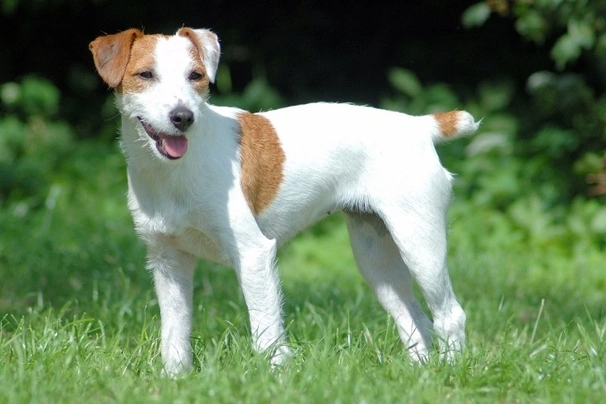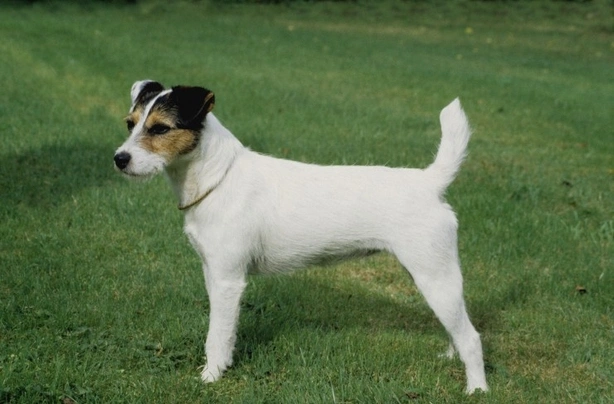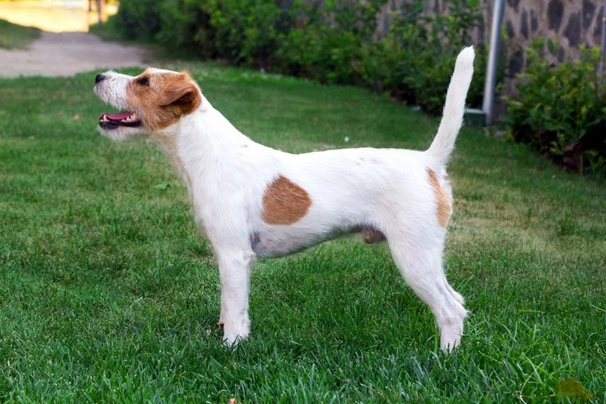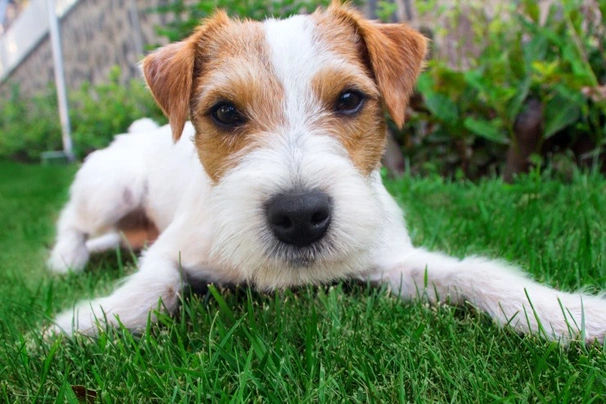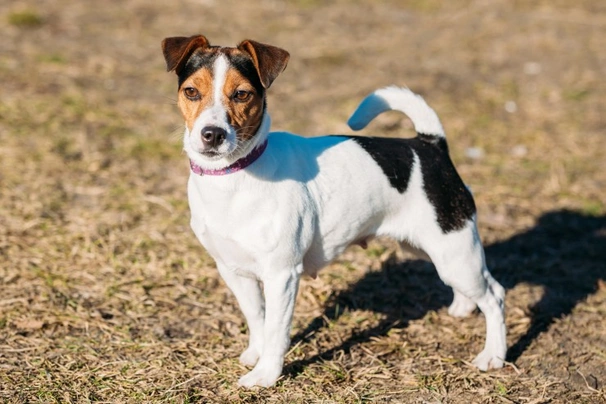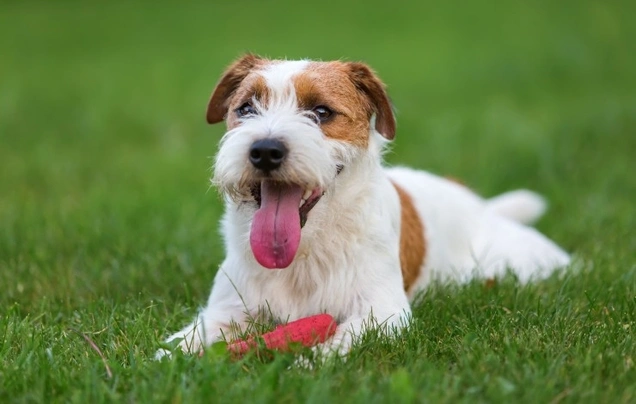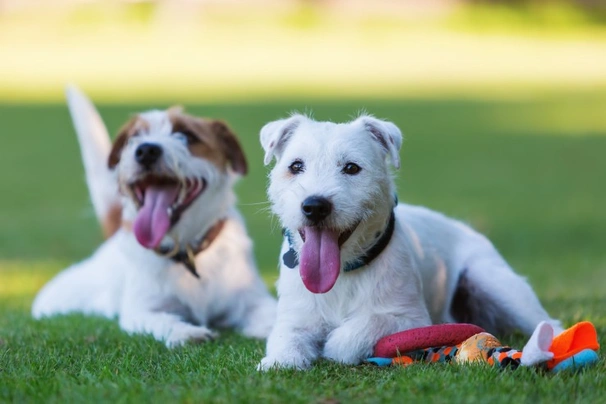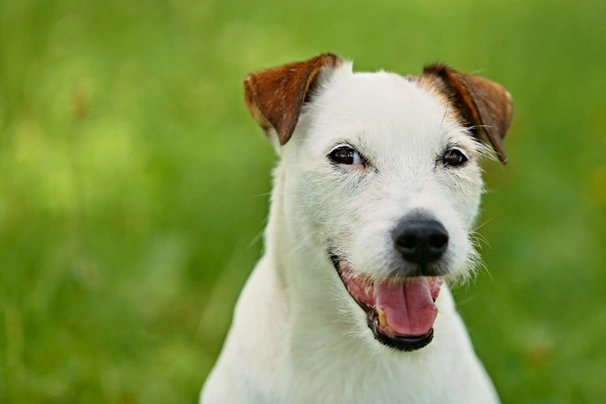Parson Russell Terrier
Pros
Cons
Introduction of the Parson Russell Terrier
The Parson Terrier is native to the UK where they were originally bred to work alongside Foxhounds although today these charming dogs are kept more as companions and family pets thanks to their kind and loyal natures. They can be rough or smooth-coated and are renowned for being alert lively terriers that are never happier than when they are outside chasing down a new scent. As such Parson Terriers are not the best choice for people who live in apartments or who lead more sedentary lives but are a very good choice for anyone living in a country environment with large secure back gardens for their dogs to roam around in whenever they can.
History of the Parson Russell Terrier
The Parsons Terrier shares a history with the Jack Russell we know today with the breed having been developed by the Reverend John Russell in the early 1800's. He purchased a dog from the milkman when he was studying at Oxford which he used to create a terrier capable of running with Foxhounds yet able to flush out a fox when needed without killing their prey which other terriers were bred to do.
The Reverend was from Dartmouth where his father who was also a clergy man owned a pack of fox hounds. In 1814 the Reverend went to university in Oxford where he was ordained five years later. He continued to be a hunting enthusiast when he was named rector of a Parish in Devon but it was during his time in Oxford that the reverend discovered a female terrier called "Trump" that was owned by a milkman and he was so impressed by the dog that he convinced the milkman that he should sell the dog to him. He took "Trump" with him to Devon where she was to become the "foundation" of his endeavours to breed the perfect hunting terrier.
Although the exact development of the breed remains a bit unclear what is known is that both the Parson Russell Terrier and the Fox Terrier are both descendants of what was referred to as "foxing terriers" that existed during the early part of the 18th Century. But with this said records were not kept of breeding practices earlier than 1862. The only thing that can be confirmed is that Reverend John Russell purchased "Trump" in or around 1818.
In 1862 that another clergy man called Reverend Handly had a female terrier called "Sting" a dog that was to become the foundation dam for the first line of Smooth Fox Terriers called the Family III. She was mated to a terrier called "Tartar" and the crossing produced a female called "Grove Nettle". Reverend John Russell himself began a breeding programme too and was the first to develop a bitch that was to become the foundation dam for Smooth Fox Terrier line known as the Family 1.
Over the ensuing years the Reverend continued his breeding programme and in 1875 the Fox Terrier Club was founded with the reverend being one of its founding members. A year later in 1876 a breed standard was established for the Fox Terrier only it described a dog the club would like to develop rather than the Fox Terrier as it then existed. Over the following years and by the end of the 18th Century Fox Terriers began to resemble the dogs we see today. However older types of "foxing terriers" still existed in more remote regions of the country and it was these "terriers" that were to become the foundation dogs of the Parson Russell Terrier.
It was only after the death of Reverend John Russell that a keen hunting man and journalist called Arthur Heinemann that a club was established which was originally known as the Devon and Somerset Badger Club. It was only later that the club's name was changed to the Parson Jack Russell Terrier Club and it was also registered along with 28 other affiliated Fox Terrier Clubs with the Kennel Club. At the time the breed standard for PRTs described these terriers as being "gay with a lively appearance with good bone and not being too long or short in the leg and a terrier that boasted the conformation like that of a mature vixen".
The club continued to prosper right up to the beginning of World War II but then closed. It was only after the war that a renewed interest in hunting that the popularity of terriers began to rise again. At the time these small terriers were all called Jack Russells. It was only by the early 1980's that enthusiasts of the Parson Russell Terrier began to promote the breed with an end goal being to gain Kennel Club recognition and as such a new Parson Jack Russell Club was founded. However the club's first application was not successful and it was not until 1990 that the Parson Jack Russell Terrier was finally recognised by the Kennel Club as being a "type or variant" of the Fox Terrier.
Finally in 1999 the Kennel Club agreed to change the breed's name to Parson Russell Terrier and in 1997 the breed was awarded CC status by the Kennel Club with a Parson Russell Terrier being crowned first champion in 1997 too. Today these charming little dogs have remained a popular choice with people both as working dogs and companions thanks to their alert and lively natures and their charming looks.
Interesting facts about the breed
- Is the Parson Terrier a vulnerable breed? No today the PRT is one of the more popular breeds in the UK being ranked 83 out of 238 breeds on the Pets4homes website
- They were originally known as Jack Parson Russell Terriers
- Parson Terriers are tenacious and never give up easily once they have spotted and chased down their prey
- They are extremely energetic and alert by nature with a very low boredom threshold
- They are renowned for being extremely skilled escape artists
- The Parson Terrier is known to be a very affectionate therapy dog
Appearance of the Parson Russell Terrier
Height at the withers: Males 36 cm Females 33 cm
Average Weight: Males 5 - 8 kg Females 5 - 8 kg
The Parson Terrier is a small compact dog that boasts a very alert and lively look about them. Their heads are wedge-shaped with dogs having a moderately broad flat skull that gets gradually narrower towards their eyes. They have a shallow stop and neat muzzle with a black nose. Their eyes are almond-shaped and dark in colour which always has an intelligent keen and alert look about them. Ears are nicely proportioned in relation to a dog's head and V-shaped. They drop forward with the very tip of the ears reaching the corner of a dog's eyes.
The Parson Terrier has a strong jaw with a perfect scissor bite where their upper teeth neatly overlap their lower ones. Their necks are muscular and clean being a nice length and widening at a dog's long sloping and well laid-back shoulders. Front legs are set well back under a dog's body and are straight and strong.
They are compact little dogs with a moderately deep chests and ribs that are set well back. Their backs are straight strong and very flexible with these terriers having strong slightly arched loins which adds to a dog's overall balanced appearance. Their back legs are well muscled strong with nicely developed second thighs.
Their feet are compact with dogs having slightly arched toes and nice firm pads. Tails are moderately long which dogs hold straight again adding to the well-balanced look of these terriers. Their tails are thicker at the base but taper towards the tip and are set quite high which dogs carry high when they are excited or alert but lower when they are at rest or relaxed.
When it comes to their coat the Parson Terrier can either have a rough or smooth coat but both are naturally coarse to the touch and lie close to a dog's body. They have a denser and closer undercoat which provides a lot of protection against the elements. The accepted breed colours for Kennel Club registration are as follows:
- Black & white
- Lemon & white
- Lemon tan & white
- Tan & white
- Tricolour
- White
- White & tan
- White black & tan
Gait/movement
When a Parson Russell Terrier moves they do so freely covering a lot of ground when they do. There should be no exaggeration in a PRT's stride and dogs should show a lot of drive in their hindquarters. They have a nicely balanced gait showing a straight action both in front and behind.
Faults
The Kennel Club frowns on any exaggerations or departures from the breed standard and would judge the faults on how much they affect a dog's overall health and wellbeing as well as their ability to perform.
Males should have both testicles fully descended into their scrotums and it is worth noting that a dog can be a little lighter or heavier as well as slightly taller or shorter than set out in the Kennel Club breed standard which is given as a guideline only.
Temperament of the Parson Russell Terrier
The Parson is a lively outgoing highly intelligent terrier and as such they need to be given a lot of daily physical exercise which must be combined with a ton of mental stimulation for them to be truly happy well-rounded and obedient characters. They thrive on being around people and resent being left on their own for long periods of time. If a Parson is left to their own devices boredom soon sets in and this could lead to a dog developing all sorts of behavioural issues which includes excessive barking and separation anxiety. As such they are a great choice for families where one person usually stays at home when everyone else is out of the house.
Their hunting instincts remain very sharp and as such if a Parson can roam around a back garden the fencing must be ultra-secure because if they find any weaknesses these terriers would soon get out to go off exploring. They are also excellent diggers which means a Parson is more than capable of digging their way out of a garden or enclosure if the mood takes them. Parsons are also known to be barkers more especially if they are left alone for long periods of time.
They are a very good choice for first time owners because they love to please which paired to the fact these terriers are so intelligent means they are easy to train loving nothing more than the one-to-one contact they get during a training session. With this said they are not the best choice for people who lead more sedentary lives because a Parson is quite demanding on the exercise front.
PRTs are renowned for being wonderful PAT dogs which sees them visit hospitals nursing homes and residential care homes with their owners which is something that patients really benefit from thanks to their fun-loving and affectionate natures.
Are they a good choice for first time owners?
Parson Terriers are a good choice for first time dog owners because they are so amenable and people-oriented loving nothing more than to please and to entertain their families. They are particularly good with young children and older people too although playtime can get a bit boisterous at times. However they are better suited to families where one person stays at home so they never spend too much time on their own.
What about prey drive?
Parson Russell Terriers have a very high prey drive and will chase anything that moves whenever they get the chance. As such care should always be taken as to where and when a dog can run off the lead especially if there are wild animals livestock or other dogs around.
What about playfulness?
PRTs have a very playful side to their natures and love to entertain and be entertained. They adore playing interactive games and are especially good at all sorts of canine sports which includes agility. They are known to be a little mischievous when the mood takes them and being so clever a Parson Terrier quickly learns what pleases and owner as well as just how far they can push the boundaries to see how much they can get away with.
What about adaptability?
Parson Terriers are highly adaptable dogs and providing they are given enough daily physical exercise combined with as much mental stimulation to prevent boredom from setting in they can live in an apartment. However they are much better suited to country living where they can be out and about as much as possible so they can expend all that pent-up energy.
What about separation anxiety?
PRTs form strong ties with their families and dogs are never very happy when they find themselves left on their own for longer periods of time. They are better suited to people who either work from home or in households where one person stays at home when everyone else is out so they are never alone for any length of time which could see a dog suffering from separation anxiety. This can lead to them being destructive around the home which is a dog's way of relieving any stress they are feeling and a way to keep themselves entertained.
What about excessive barking?
Some PRTs like the sound of their own voices a little too much which is something that needs to be gently nipped in the bud when a dog is still young being careful not to frighten them. Others will only bark when there are strangers about as well as when something they don't like is going on in their surroundings. They also like to bark when they find a rodent or other small animal that's "gone to ground".
Do Parson Russell Terriers like water?
Some PRTs love swimming and will take to the water whenever they can more especially when the weather is hot. However if anyone who owns a dog that does not like water should never force them to go in because it would just end up scaring them. With this said care should always be taken when walking a Parson Terrier off the lead anywhere near more dangerous watercourses just in case a dog decides to leap in and then needs rescuing because they can't get out of the water on their own.
Are Parson Russells good watchdogs?
PRTs are good watchdogs and are always quick off the mark to let an owner know when strangers are about. However rarely would a Parson Terrier show any sort of aggression to people they don't know preferring to keep their distance and bark as a way of alerting an owner to a situation.
Intelligence / Trainability of the Parson Russell Terrier
Parson Terriers are highly intelligent and they excel at all sort of canine sports which includes mini agility but like many other terrier breeds they can have a bit of stubborn streak in them. As such their socialisation and training must start early with dogs being introduced to new situations people animals and other pets as soon as dogs are fully vaccinated. Other activities that PRTs thoroughly enjoy because it helps them get rid of all their pent-up energy includes things like flyball.
Their training and education must be consistent and always fair because these little terriers respond well to being taught new things with a firm yet gentle hand. They do not answer well to any sort of harsh correction or heavy-handed training. With this said owners need to pay attention to the recall command because Parson Terriers are known to turn a deaf ear if they pick up a more interesting scent when they can run off their leads.
The key to successfully training a Parson Terrier is to make sure things are kept interesting because of they are known to have very low boredom thresholds and because they are independent thinkers by nature which means they are quick to be distracted by more "interesting" things that may be going on around them. A well-trained Parson Terrier is a pleasure to have around and can even be seen competing in obedience trials.
Like all puppies a Parson Terrier is adorable when young and it is all too easy to let them get away with things. However owners need to start out as they mean to go on because spoiling a PRT can make a dog harder to live with when they are older. Puppies must be gently taught their place in the pack and what is acceptable behaviour and what is not. As such the first commands a puppy should be taught as early as possible are as follows:
- Come
- Sit
- Stay
- Quiet
- Leave it
- Down
- Bed
Children and other
Parson Terriers are known to be good around children especially if they have grown up together. However any interaction between children and a dog should always be supervised by an adult to make sure playtime does not get too boisterous which could end up with a child getting hurt or scared albeit by accident.
Care must be taken when a Parson meets any other small animals and pets because of their high prey drive. Even when they have been well socialised from a young age the terrier in a Parson tends to get the better of them when they meet small pets and other animals. They can be a little dominant around other dog and more especially when they meet any other terriers so care must be taken when out on a walk in a public place.
Health of the Parson Russell Terrier
The average life expectancy of a Parson Terrier is between 9 and 15 years when properly cared for and fed an appropriate good quality diet to suit their ages.
The Parson is known to be a healthy breed and as such they are considered as being a Category One breed on the Kennel Club Breed Watch Scheme which establishes that there are no health concerns known to affect the Parson Russell Terrier. With this said the health concerns that most affect a PRT are as follows:
- Hereditary deafness - DNA test available through the Animal Health Trust
- Primary lens luxation - DNA test available through the Animal Health Trust
- Late onset ataxia (LOA) - DNA test available through the Animal Health Trust
- Spinocerebellar ataxia (SCA) - DNA test available through the Animal Health Trust
- Urate stones (HUU/Canine hyperuricosuria - DNA test available through the Animal Health Trust
What about vaccinations?
Parson Russell Terrier puppies would have been given their initial vaccinations before being sold but it is up to their new owners to make sure they have their follow-up shots in a timely manner with the vaccination schedule for puppies being as follows:
- 10 -12 weeks old bearing in mind that a puppy would not have full protection straight away but would be fully protected 2 weeks after they have had their second vaccination
There has been a lot of discussion about the need for dogs to have boosters. As such it's best to talk to a vet before making a final decision on whether a dog should continue to have annual vaccinations which are known as boosters.
What about spaying and neutering?
A lot of vets these days recommend waiting until dogs are slightly older before spaying and neutering them which means they are more mature before undergoing the procedures. As such they advise neutering males and spaying females when they are between the ages of 6 to 9 months old and sometimes even when a dog is 12 months old.
Other vets recommend spaying and neutering dogs when they are 6 months old but never any earlier unless for medical reasons. With this said many breeds are different and it is always advisable to discuss things with a vet and then follow their advice on when a dog should be spayed or neutered.
What about obesity problems?
Some Parson Terriers gain weight after they have been spayed or neutered and it's important to keep an eye on a dog's waistline just in case they do. If a dog starts to put on weight it's important to adjust their daily calorie intake and to up the amount of exercise they are given. Older dogs too are more prone to gaining weight and again it's essential they be fed and exercised accordingly because obesity can shorten a dog's life by several years. The reason being that it puts a lot of extra strain on a dog's internal organs including the heart which can prove fatal.
What about allergies?
Occasionally a Parson might develop an allergy and it's important for a dog to see a vet sooner rather than later if one flares up. Allergies can be notoriously hard to clear up and finding the triggers can be challenging. With this said a vet would be able to make a dog with an allergy more comfortable while they try to find out the triggers which could include the following:
- Certain pet foods that contain high levels of grain and other cereal based fillers
- Airborne pollens
- Dust mites
- Environment
- Flea and tick bites
- Chemicals found in everyday household cleaning products
Participating in health schemes
All responsible Parson Russell Terrier breeders would ensure that their stud dogs are tested for known hereditary and congenital health issues known to affect the breed by using the following schemes:
- BAER test for deafness through the Animal Health Trust
- DNA test Primary lens luxation (PLL) through the Animal Health Trust
- DNA Test Late onset ataxia (LOA) through the Animal Health Trust
- DNA test Spinocerebellar ataxia (SCA) through the Animal Health Trust
- DNA test Urate stones (HUU/Canine hyperuricosuria through The Animal Health Trust (AHT)
What about breed specific breeding restrictions?
Apart from the standard breeding restrictions set out for all Kennel Club registered breeds there are no other breed specific breeding restrictions in place for the Parson Terrier.
What about Assured Breeder Requirements?
It is mandatory for all Assured Breeders to use the following tests on their stud dogs and the Kennel Club strongly recommends that other breeders also follow suit:
- DNA test - PLL - through AHT
- DNA test - LOA - through AHT
- DNA test - SCA - through AHT
The Kennel Club also recommends that all breeders use the following scheme on breeding stock:
Caring for the Parson Russell Terrier
As with any other breed Parsons need to be groomed on a regular basis to make sure their coats and skin are kept in top condition. They also need to be given regular daily exercise to ensure they remain fit and healthy. On top of this dogs need to be fed good quality food that meets all their nutritional needs throughout their lives.
Caring for a Parson Russell Terrier puppy
Parson puppies are boisterous and full of life which means it's essential for homes and gardens to be puppy-proofed well in advance of their arrival. A responsible breeder would have well socialised their puppies which always leads to more outgoing confident and friendly dogs right from the word go. With this said any puppy is going to feel vulnerable when they leave their mother and littermates which must be taken into account. The longer a puppy can remain with their mother the better although it should never be for too long either.
It's best to pick a puppy up when people are going to be around for the first week or so which is the time needed for a puppy to settle in. Puppy-proofing the home and garden means putting away any tools and other implements that a boisterous puppy might injure themselves on. Electric wires and cables must be put out of their reach because puppies love chewing on things. Toxic plants should be removed from flowerbeds and the home too.
Puppies need to sleep a lot to grow and develop as they should which means setting up a quiet area that's not too out of the way means they can retreat to it when they want to nap and it's important not to disturb them when they are sleeping. It's also a good idea to keep "playtime" nice and calm inside the house and to have a more active "playtime" outside in the garden which means puppies quickly learn to be less boisterous when they are inside.
The documentation a breeder provides for a puppy must have all the details of their worming date and the product used as well as the information relating to their microchip. It is essential for puppies to be wormed again keeping to a schedule which is as follows:
- Puppies should be wormed at 6 months old
- They need to be wormed again when they are 8 months old
- Puppies should be wormed when they are 10 months old
- They need to be wormed when they are 12 months old
Things you'll need for your puppy
There are certain items that new owners need to already have in the home prior to bringing a new puppy home. It's often a good idea to restrict how much space a puppy plays in more especially when you can't keep an eye on what they get up to bearing in mind that puppies are often quite boisterous which means investing in puppy gates or a large enough playpen that allows a Parson puppy the room to express themselves while keeping them safe too. The items needed are therefore as follows:
- Good quality puppy or baby gates to fit on doors
- A good well-made playpen that's large enough for a puppy to play in so they can really express themselves as puppies like to do
- Lots of well-made toys which must include good quality chews suitable for puppies to gnaw on bearing in mind that a puppy will start teething anything from when they are 3 to 8 months old
- Good quality feed and water bowls which ideally should be ceramic rather than plastic or metal
- A grooming glove
- A slicker brush or soft bristle brush
- Dog specific toothpaste and a toothbrush
- Scissors with rounded ends
- Nail clippers
- Puppy shampoo and conditioner which must be specifically formulated for use on dogs
- A well-made dog collar or harness
- A couple of strong dog leads
- A well-made dog bed that's not too small or too big
- A well-made dog crate for use in the car and in the home that's large enough for a puppy to move around in
- Baby blankets to put in your puppy's crate and in their beds for when they want to nap or go to sleep at night
Keeping the noise down
All puppies are sensitive to noise including Parson Terrier puppies. It's important to keep the noise levels down when a new puppy arrives in the home. TVs and music should not be played too loud which could end up stressing a small puppy out.
Keeping vet appointments
As previously mentioned Parson puppies would have been given their first vaccinations by the breeders but they must have their follow up shots which is up to their new owners to organise. The vaccination schedule for puppies is as follows:
- 10 -12 weeks old bearing in mind that a puppy would not have full protection straight away but would only be fully protected 2 weeks after they have had their second vaccination
When it comes to boosters it's best to discuss these with a vet because there is a lot of debate about whether a dog really needs them after a certain time. However if a dog ever needed to go into kennels their vaccinations would need to be
What about older Parson Russell Terriers when they reach their senior years?
Older Parsons need lots of special care because as they reach their golden years they are more at risk of developing certain health concerns. Physically a dog's muzzle may start to go grey but there will be other noticeable changes too which includes the following:
- Coats become coarser
- A loss of muscle tone
- They can either become overweight or underweight
- They have reduced strength and stamina
- Older dogs have difficulty regulating their body temperature
- They often develop arthritis
- Immune systems do not work as efficiently as they once did which means dogs are more susceptible to infections
Older dogs change mentally too which means their response time tends to be slower as such they develop the following:
- They respond less to external stimuli due to impaired vision or hearing
- They tend to be a little pickier about their food
- They have a lower pain threshold
- Become intolerant of any change
- Often an older dog can feel disorientated
Living with a Parson Russell Terrier in their golden years means taking on a few more responsibilities but these are easily managed and should include taking a look at their diet the amount of exercise they are given how often their dog beds need changing and keeping an eye on the condition of their teeth.
Older PRTs need to be fed a good quality diet that meets their needs at this stage of their lives all the while keeping a close eye on a dog's weight. A rough feeding guide for older Parsons is as follows bearing in mind they should be fed highly digestible food that does not contain any additives:
- Protein content should be anything from 14 – 21%
- Fat content should be less than 10%
- Fibre content should be less than 4%
- Calcium content should be 0.5 – 0.8%
- Phosphorous content should be 0.4 – 0.7%
- Sodium content should be 0.2 – 0.4%
Older Parsons don't need to be given the same amount of daily exercise as a younger dog but they still need the right amount of physical activity to maintain muscle tone and to prevent a dog from putting on too much weight. All dogs need access to fresh clean water and this is especially true of older dogs when they reach their golden years because they are more at risk of developing kidney disorders.
Grooming of the Parson Russell Terrier
The Parson Terrier has a dense double coat however they are low maintenance when it comes to keeping their coats looking good which is particularly true of smooth-coated dogs. Rough coated dogs need a little more coat care which involves having their coats hand stripped several times a year which is a task that's best left up to a dog groomer. This makes it a lot easier for owners to keep a dog’s coat tidy in between visits to a grooming parlour.
Both smooth and rough coated dogs shed throughout the year but they tend to shed the most during the Spring and then again in the Autumn when more frequent brushing is usually necessary to keep on top of things. At other times of the year a weekly brush is all that's needed to take out any shed and dead hair from a dog's coat.
It's also important to check a dog's ears on a regular basis and to clean them when necessary. If too much wax builds up in a dog's ears it can lead to a painful infection which can be hard to clear up. In short prevention is often easier than cure when it comes to ear infections.
Exercise of the Parson Russell Terrier
Parson Terriers are high energy little dogs and as such they need to be given at least 60 minutes exercise a day. A shorter walk in the morning would be fine but a longer more interesting one in the afternoon is a must. These dogs also like to be able to roam around a back garden as often as possible so they can really let off steam. However the fencing must be extremely secure to keep these lively and energetic terriers in because if they find a weakness in the fence they will soon escape out and get into all sorts of trouble. The Parson is an expert digger and they love nothing more than digging up a garden whenever they feel bored which another thing that owners need to bear in mind when they let a Parson run free in a back garden.
With this said Parson puppies should not be over exercised because their joints and bones are still growing and too much pressure on them could result in causing a few problems later in a dog’s lives. They should not be allowed to jump up or off furniture nor should they be allowed to run up and down the stairs because these are the sorts of things that do put a lot of pressure on their fragile and growing joints.
Feeding of the Parson Russell Terrier
If you get a Parson puppy from a breeder they would give you a feeding schedule and it's important to stick to the same routine feeding the same puppy food to avoid any tummy upsets. You can change a puppy's diet but this needs to be done very gradually always making sure they don't develop any digestive upsets and if they do it's best to put them back on their original diet and to discuss things with the vet before attempting to change it again.
Older dogs are not known to be fussy or finicky eaters but this does not mean you can feed them a lower quality diet. It's best to feed a mature dog twice a day once in the morning and then again in the evening making sure it's good quality food that meets all their nutritional requirements. It's also important that dogs be given the right amount of exercise so they burn off any excess calories or they might gain too much weight which can lead to all sorts of health issues. Obesity can shorten a dog's life by several years so it's important to keep an eye on their waistline from the word go.
Feeding guide for a Parson Russell Terrier puppy
Puppies need to be fed a highly nutritious good quality diet for them to develop and grow as they should. As a rough guide a Parson Russell Terrier puppy can be fed the following amounts every day making sure their meals are evenly spread out throughout the day and it's best to feed them 3 or 4 times a day:
- 2 months old - 92g to 125g depending on puppy's build
- 3 months old - 108g to 150g depending on puppy's build
- 4 months old - 114g to 161g depending on puppy's build
- 5 months old - 115g to 164g depending on puppy's build
- 6 months old - 114 g to 163g depending on puppy's build
- 7 months old - 102g to 146g depending on puppy's build
- 9 months old - 90g to 128g depending on puppy's build
- 10 months old - 78g to 112g depending on puppy's build
Once a puppy is 11 months old they can be fed adult dog food.
Feeding guide for an adult Parson Russell Terrier
Once fully mature an adult Parson Russell Terrier must be fed a good quality diet to ensure their continued good health. As a rough guide an adult PRT can be fed the following amounts every day:
- Dogs weighing 5 kg can be fed 80g to 93g depending on activity
- Dogs weighing 6 kg can be fed 92g to 106g depending on activity
- Dogs weighing 7 kg can be fed 103g to 119g depending on activity
- Dogs weighing 8 kg can be fed 114g to 132g depending on activity
Parson Russell Terrier price
If you are looking to buy a Parson Russell Terrier you would need to pay anything from £500 to over £1000 for a well-bred pedigree puppy.
The cost of insuring a male 3-year-old Parson Terrier in northern England would be £19.69 a month for basic cover but for a lifetime policy this would set you back £38.21 a month (quote as of November 2017). When insurance companies calculate a pet's premium they factor in several things which includes where you live in the UK and a dog's age and whether they have been neutered or spayed.
When it comes to food costs you need to buy the best quality food whether wet or dry to feed your dog throughout their lives making sure it suits the different stages of their lives. This would set you back between £20 - £30 a month. On top of this you would need to factor in veterinary costs if you want to share your home with a Parson Terrier and this includes their initial vaccinations their annual boosters the cost of neutering or spaying your dog when the time is right and their yearly health checks all of which quickly adds up to over £800 a year.
As a rough guide the average cost to keep and care for a Parson Terrier would be between £50 to £70 a month depending on the level of insurance cover you opt to buy for your dog but this does not include the initial cost of buying a healthy well-bred Kennel Club registered pedigree Parson Terrier puppy.
Buying advice
When visiting and buying any puppy or dog there are many important things to consider and questions to ask of the breeder/seller. You can read our generic puppy/dog advice here which includes making sure you see the puppy with its mother and to verify that the dog has been wormed and microchipped.
Parson Russell Terriers are an extremely popular breed both in the UK and elsewhere in the world which means that well-bred puppies command a lot of money. As such with PRTs there is specific advice questions and protocols to follow when buying a puppy which are as follows:
- Beware of online scams and how to avoid them. You may see online and other adverts by scammers showing images of beautiful Parson Terrier puppies for sale at very low prices. However the sellers ask buyers for money up front before agreeing to deliver a puppy to a new home. Potential buyers should never buy a puppy unseen and should never pay a deposit or any other money online to a seller. You should always visit the pet at the sellers home to confirm they are genuine and make a note of their address.
- As previously touched upon PRTs are among some of the most popular breeds in the UK. As such there are many amateur breeders/people who breed from dam far too often so they can make a quick profit without caring for the welfare of the puppies their dam or the breed in general. Under Kennel Club rules a dam can only produce 4 litters and she must be between a certain age to do so. Anyone wishing to buy a Parson Russell Terrie puppy should think very carefully about who they purchase their puppy from and should always ask to see the relevant paperwork pertaining to a puppy's lineage their vaccinations and their microchipping.
- Prospective Parson Terrier owners should be very careful when considering buying an extra small puppy because all too often they suffer from very serious health issues and no responsible breeder would purposefully breed dogs so they are too small.
- White coated dogs often suffer from congenital deafness as such anyone interested in buying a PRT with a white coat should ask the breeder whether parent dogs have been BAER tested.

Kc registered parson Russell Terrier
£1,500
One remaining puppy looking for a forever home
£1,150
Beautiful working terrier pups
£750
